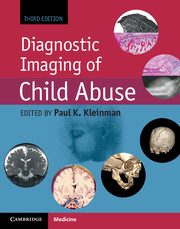Book contents
- Frontmatter
- Dedication
- Contents
- List of Contributors
- Editor’s note on the Foreword to the third edition
- Foreword to the third edition
- Foreword to the second edition
- Foreword to the first edition
- Preface
- Acknowledgments
- List of acronyms
- Introduction
- Section I Skeletal trauma
- Chapter 1 The skeleton: structure, growth and development, and basis of skeletal injury
- Chapter 2 Skeletal trauma: general considerations
- Chapter 3 Lower extremity trauma
- Chapter 4 Upper extremity trauma
- Chapter 5 Bony thoracic trauma
- Chapter 6 Dating fractures
- Chapter 7 Differential diagnosis I: diseases, dysplasias, and syndromes
- Chapter 8 Differential diagnosis II: disorders of calcium and phosphorus metabolism
- Chapter 9 Differential diagnosis III: osteogenesis imperfecta
- Chapter 10 Differential diagnosis IV: accidental trauma
- Chapter 11 Differential diagnosis V: obstetric trauma
- Chapter 12 Differential diagnosis VI: normal variants
- Chapter 13 Evidence-based radiology and child abuse
- Chapter 14 Skeletal imaging strategies
- Chapter 15 Postmortem skeletal imaging
- Section II Abusive head and spinal trauma
- Section III Visceral trauma and miscellaneous abuse and neglect
- Section IV Diagnostic imaging of abuse in societal context
- Section V Technical considerations and dosimetry
- Index
- References
Chapter 10 - Differential diagnosis IV: accidental trauma
from Section I - Skeletal trauma
Published online by Cambridge University Press: 05 September 2015
- Frontmatter
- Dedication
- Contents
- List of Contributors
- Editor’s note on the Foreword to the third edition
- Foreword to the third edition
- Foreword to the second edition
- Foreword to the first edition
- Preface
- Acknowledgments
- List of acronyms
- Introduction
- Section I Skeletal trauma
- Chapter 1 The skeleton: structure, growth and development, and basis of skeletal injury
- Chapter 2 Skeletal trauma: general considerations
- Chapter 3 Lower extremity trauma
- Chapter 4 Upper extremity trauma
- Chapter 5 Bony thoracic trauma
- Chapter 6 Dating fractures
- Chapter 7 Differential diagnosis I: diseases, dysplasias, and syndromes
- Chapter 8 Differential diagnosis II: disorders of calcium and phosphorus metabolism
- Chapter 9 Differential diagnosis III: osteogenesis imperfecta
- Chapter 10 Differential diagnosis IV: accidental trauma
- Chapter 11 Differential diagnosis V: obstetric trauma
- Chapter 12 Differential diagnosis VI: normal variants
- Chapter 13 Evidence-based radiology and child abuse
- Chapter 14 Skeletal imaging strategies
- Chapter 15 Postmortem skeletal imaging
- Section II Abusive head and spinal trauma
- Section III Visceral trauma and miscellaneous abuse and neglect
- Section IV Diagnostic imaging of abuse in societal context
- Section V Technical considerations and dosimetry
- Index
- References
Summary
Introduction
Accidental injury, especially from falls, is a global concern, and is the most common cause of early childhood morbidity and mortality (1–7). The extent of the problem and the relative contributions of accidental and abusive etiologies have been described elsewhere in this text, in particular in Chapter 2. Although most injuries that raise the concern of abuse are often accompanied by a history of an accidental fall, it is not uncommon for an accidental mechanism entailing an applied manual force by a caretaker or sibling to be offered at presentation, or after a fracture is documented radiographically. The elements and dynamics of these cases can challenge efforts to dichotomize injuries into accidental versus nonaccidentalorintentional versus unintentional etiologies. These distinctions may be possible in cases where the severity of the injury far exceeds that expected with the history, or where the purported mechanism is entirely consistent with the injury. However, many cases fall between these extremes and are not simply classified as abusive or accidental. The most challenging cases are often those in which the purported mechanism is plausible, but the magnitude of the forces required to produce the injury would appear to exceed those customarily applied by a competent caretaker. For example, a young child may attempt to roll a recumbent infant from a prone to supine position, resulting in a humerus fracture, but would such an event be an accident in the hands of a typical teenager or adult caretaker? If a frustrated adult forcefully “bicycles” a child’s legs resulting in an extremity fracture, is this an unintentional/accidental injury? The terms “unintentional” and “nonaccidental” may have clear legal definitions, but are less easily applied in the clinical setting. Efforts to describe an injury by what it is not (nonaccidental/unintentional) are inherently problematic. The decision of the American Board of Pediatrics to name their subspecialty that focuses on maltreatment Child Abuse Pediatrics reflects the group’s preferred nomenclature and intention to place this complex disorder in a suitable framework (8). With an understanding of the limitations of this terminology, the contrasting terms child abuse and accidental injury are used throughout this text.
- Type
- Chapter
- Information
- Diagnostic Imaging of Child Abuse , pp. 268 - 278Publisher: Cambridge University PressPrint publication year: 2015
References
- 1
- Cited by



